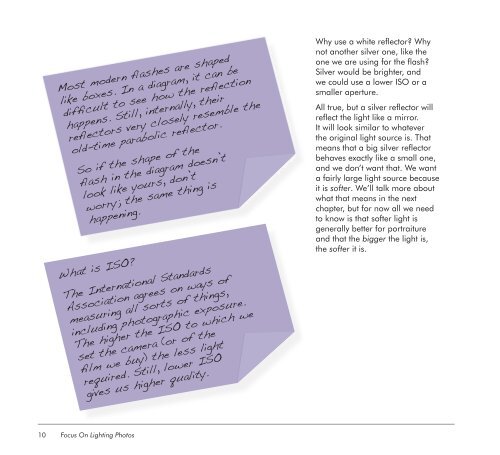Focus On Lighting Photos Focus on the Fundamentals.pdf
You also want an ePaper? Increase the reach of your titles
YUMPU automatically turns print PDFs into web optimized ePapers that Google loves.
10<br />
Most modern flashes are shaped<br />
like boxes. In a diagram, it can be<br />
difficult to see how <strong>the</strong> reflecti<strong>on</strong><br />
happens. Still, internally, <strong>the</strong>ir<br />
reflectors very closely resemble <strong>the</strong><br />
old-time parabolic reflector.<br />
So if <strong>the</strong> shape of <strong>the</strong><br />
flash in <strong>the</strong> diagram doesn’t<br />
look like yours, d<strong>on</strong>’t<br />
worry; <strong>the</strong> same thing is<br />
happening.<br />
What is ISO?<br />
The Internati<strong>on</strong>al Standards<br />
Associati<strong>on</strong> agrees <strong>on</strong> ways of<br />
measuring all sorts of things,<br />
including photographic exposure.<br />
The higher <strong>the</strong> ISO to which we<br />
set <strong>the</strong> camera (or of <strong>the</strong><br />
film we buy) <strong>the</strong> less light<br />
required. Still, lower ISO<br />
gives us higher quality.<br />
<str<strong>on</strong>g>Focus</str<strong>on</strong>g> <str<strong>on</strong>g>On</str<strong>on</strong>g> <str<strong>on</strong>g>Lighting</str<strong>on</strong>g> <str<strong>on</strong>g>Photos</str<strong>on</strong>g><br />
Why use a white reflector? Why<br />
not ano<strong>the</strong>r silver <strong>on</strong>e, like <strong>the</strong><br />
<strong>on</strong>e we are using for <strong>the</strong> flash?<br />
Silver would be brighter, and<br />
we could use a lower ISO or a<br />
smaller aperture.<br />
All true, but a silver reflector will<br />
reflect <strong>the</strong> light like a mirror.<br />
It will look similar to whatever<br />
<strong>the</strong> original light source is. That<br />
means that a big silver reflector<br />
behaves exactly like a small <strong>on</strong>e,<br />
and we d<strong>on</strong>’t want that. We want<br />
a fairly large light source because<br />
it is softer. We’ll talk more about<br />
what that means in <strong>the</strong> next<br />
chapter, but for now all we need<br />
to know is that softer light is<br />
generally better for portraiture<br />
and that <strong>the</strong> bigger <strong>the</strong> light is,<br />
<strong>the</strong> softer it is.



